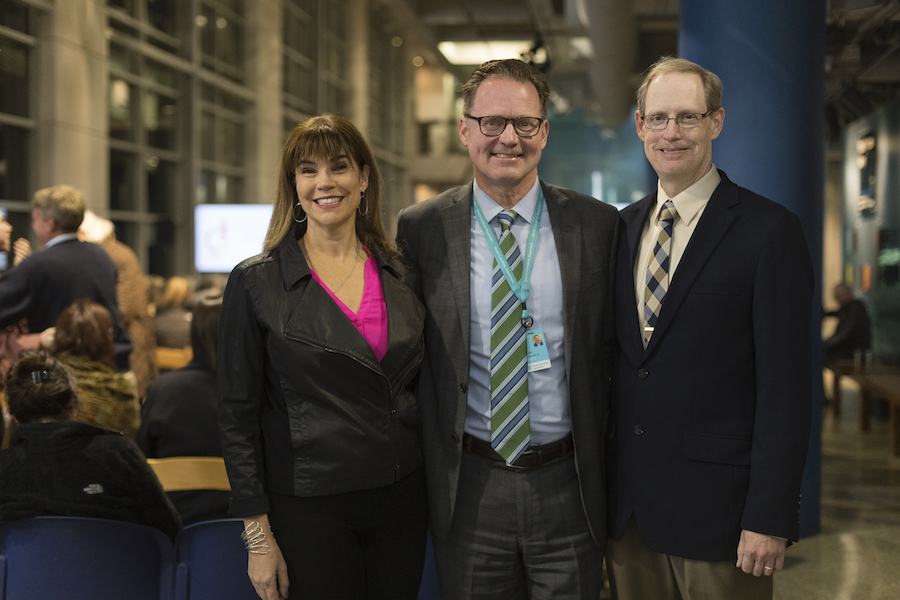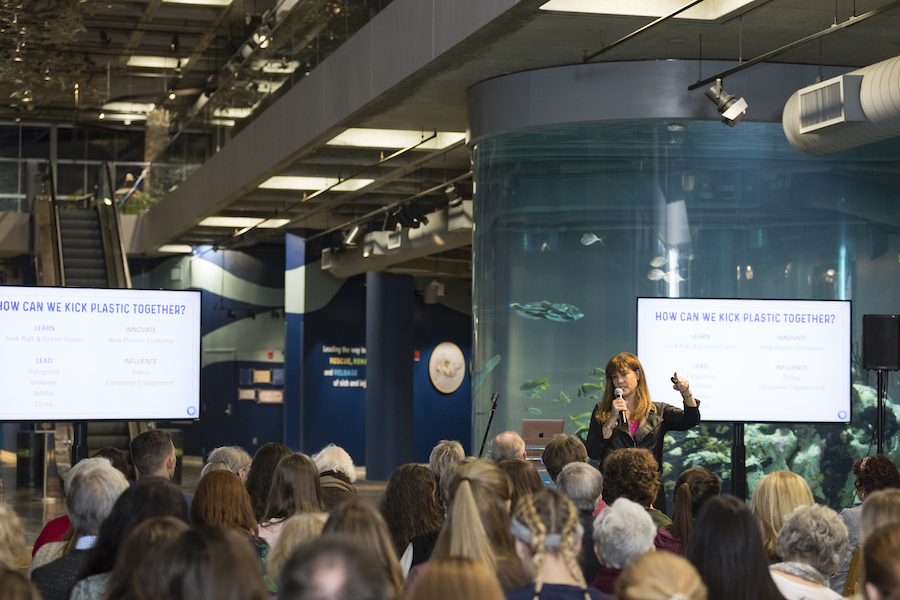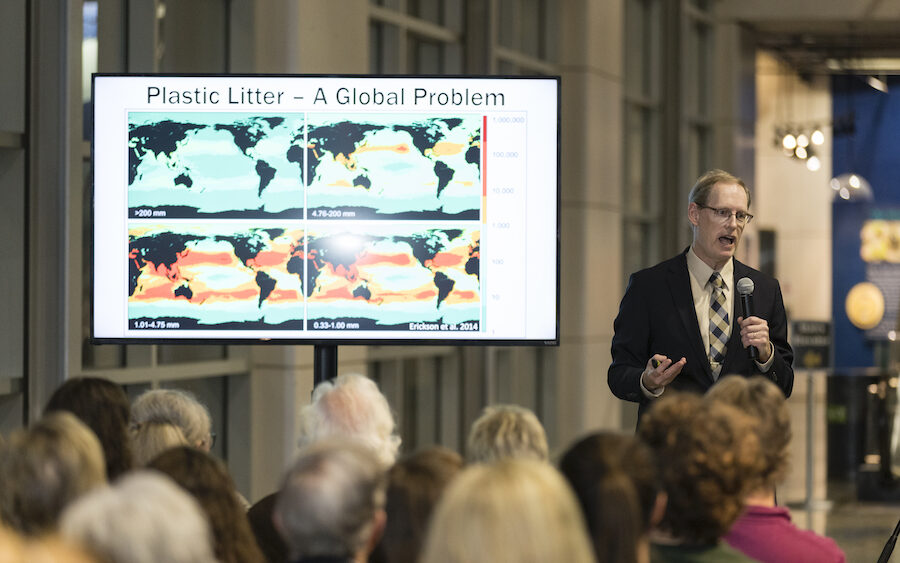On November 21, guests flooded into the South Carolina Aquarium’s Great Hall with one thing on their mind: plastic. The third Holland Lifelong Learning lecture of the season featured not one, but two plastic experts, Dr. John Weinstein, chair of biology at the Citadel, and Lia Colabello, principal of Plastic Pollution Solutions. At first glance, these two experts seemed to have very different backgrounds — Weinstein an expert in toxicology and physiology and Colabello an expert in sustainable business. However, both speakers were inspired by the ocean at a young age. Weinstein grew up spending summers on the Jersey shore asking questions about every beach find. Colabello grew up on Oahu’s North Shore continuing her family’s traditions of celestial way-finding and sailing.

Weinstein kicked off the evening debunking the many myths about plastic pollution. Did you know that the “Great Pacific Garbage Patch” is not really an island of floating trash? “If you were to venture many miles offshore, you wouldn’t notice a difference at first glance,” he said. However, many small plastic bits are interspersed.
Microplastics are toxin absorbing pieces of plastic less than 5-millimeters long. Microplastics are grouped in primary and secondary categories. Last year, a piece of legislation called the Microbead Free Waters Act was passed that eliminated primary microplastics,or pre-production pieces from toothpastes, face wash and anything else that would be applied and immediately rinsed down the sink. Thanks to groups like 5 Gyres, this was a powerful step forward. However, pre-production plastics like these make up only 1% of the plastic found in the Citadel lab research. The remainder of plastic bits comes from secondary sources like discarded single-use plastic. It’s estimated that one styrofoam plate will break down into 46,354 microplastics. The myth that plastic takes decades to break down is also not true for the Lowcountry. Weinstein’s students have shown that it takes as little as four weeks for a large piece of plastic to shed microplastics.
Weinstein and his students can determine the source of plastic by looking at the shape of the plastic pieces. Samples usually yield foam, fiber and fragment. Their ongoing research focuses on source, abundance and toxicity of plastic particles.
After mythbusting, it was time for a mystery. Many projects in the area were yielding small, jagged black fragments. What could these pieces be from? Students looked at silt fencing, erosion control tarping, fishing nets and even the plastic mesh from oyster bags. The audience clung to the edge of their seats wondering what these black particles could be and where they were coming from. Further sampling showed that three times the amount of black bits were found around Daniel Island. Discovering polybutadiene and carbon black in the samples gave researchers a lead. They sampled under bridges and in drainage ditches and solved the mystery: the fragments were from car tires! Tire material picks up minerals from the asphalt making it difficult to identify at first. A subsequent study, monitoring the diet and feeding habitats of the translucent grass shrimp, showed that animals at the bottom of the food chain are ingesting plastics, and that it takes seven times longer for grass shrimp to defecate the tire bits. It’s estimated that 21-tons of tire participles enter the surrounding waterways from our local bridges annually. Weinstein, his colleagues and his students are now looking into ways to capture these particles before they enter the surrounding waterways. (Learn more about the tire fragments discovered in Charleston Harbor.)

As Weinstein mentioned, solving these problems will take innovative ideas. Who better to lead organizations into this new mindset than Lia Colabello of Plastic Pollution Solutions. She noted that corporations are to blame for the “throwaway culture” that emerged after World War II. No longer supplying to the war effort, plastic marketing was targeted to the average household. Solving the plastic pollution epidemic is a four-part approach at the consumer, corporate, waste and policy level. Colabello was influential in recent policy successes, including the Microbead Free Waters Act and widespread single-use plastic ban. However, the biggest impact is made on the corporate level. “The times of Milton Friedman’s teachings are behind us, as the business world is experiencing a paradigm shift,” proclaimed Colabello. The current “stakeholder theory” focuses on people, plant and profit. This new business model is largely influenced by “Gen Zers,” those born between 1996 and 2010. This younger age group is making their dollar count by only supporting businesses that are environmentally conscious. This consumer challenge prompts businesses to challenge one another. The “take, make, waste” mindset has been replaced with a full circle resource model. Examples include Costa sunglasses teaming up with Bureo, a company started by a group of surfers wanting to make a difference. Bureo pays Chilean fisherman for damaged nets, melts them down to pre-production pellets and is able to mold skateboards and even sunglasses. Adidas has teamed up with Parley to collect plastic waste from remote beaches and use it as the raw material for sportswear and an exceptionally popular sneaker.
Colabello concluded with a picture of her son jumping into the ocean and shared, “Many of us in this room are part of the last generation to experience a plastic-free ocean. Although our children and children’s children will not experience this, we have the power to stop this problem from getting worse.”
Before and after this lecture, guests were invited to learn more from area groups combating plastic pollution. Representatives from the South Carolina Aquarium conservation team, Charleston Waterkeeper, The Citadel, The Surfrider Foundation Charleston Chapter, The Coastal Conservation League, The College of Charleston Office of Sustainability, Vertical Roots and Charleston Clean-up were on hand to showcase their efforts.
Thank you to our sponsors, Mary and Mason Holland and Christopher Kauker of Ameriprise Financial for making this evening possible. Join us in the new year for the last three lectures of the season. Secure your spot today!


